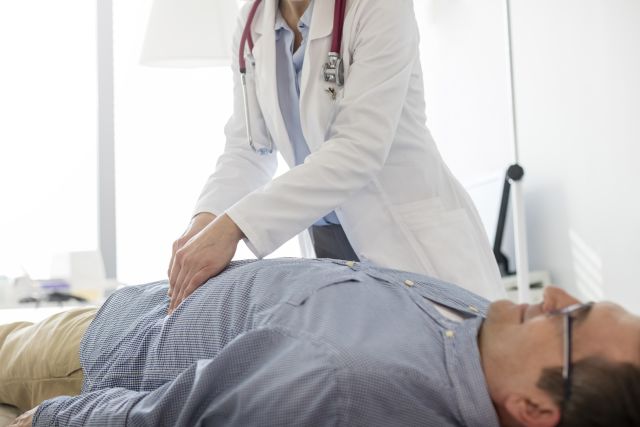Do you notice a bulge or have dull pain below the belt? You may assume that you have a pulled muscle, but your symptoms could signal a more serious problem.
Normally, the muscles and tissue of your abdominal wall keep your organs safely tucked inside. But sometimes, a weak spot or tear in the muscle in your lower belly allows a bit of fat or a piece of your intestines to poke through. If this happens in the area where your thigh meets your torso, you’ve got a groin hernia.
They are pretty common, but groin hernias shouldn’t be ignored. Here’s how to spot one—and how it should be treated to avoid dangerous complications.
How do they happen?
The reasons a groin hernia may develop depend on what type it is and exactly where the weak point in the abdominal wall is located. Groin hernias fall into three categories:
Indirect inguinal hernia: This is the most common type. It’s caused by a birth defect on the upper end of a natural passageway in the lower abdominal wall called the inguinal canal. In men, this is the route the testicles take when moving down from the abdomen to the scrotum. In women, it contains the round ligaments, which support the uterus.
In baby girls, the inguinal canal usually closes naturally before birth, while it may take up to a few weeks to close up in boys. If it doesn’t close, however, organs can slip into the space, causing a groin hernia. This type of hernia is often diagnosed and repaired within the first year of a person’s life but if it’s undetected or left untreated, it could become a problem later on.
Direct inguinal hernia: This type is caused by muscle weakness around the inguinal canal due to persistent strain or aging.
Femoral hernia: The femoral canal, which sits just below the inguinal canal in the lower abdomen, houses blood vessels that run from your belly to your legs. A hernia there may appear as a lump or bulge near the top of your thigh.
Are you at risk?
Hernias can affect anyone, but your risk increases as you age. Men are also more likely to develop a groin hernia than women, according to David Ford, MD, a surgeon affiliated with Trident Medical Center, in Charleston, South Carolina.
In fact, about 25 percent of men will develop a groin hernia at some point during their lives, compared to less than 5 percent of women.
Femoral hernias, which are much more rare than inguinal hernias, are the exception to this rule. This type of groin hernia occurs more often among women, possibly due to strain from childbirth or the fact that women have a wider pelvis and tend to have less muscle than men.
Weakness in the connective tissue of the abdominal wall due to issues with collagen—a protein that’s essential for healthy skin, bones, tendons, ligaments and muscles—may also play a role.
“We know now that some people’s collagen isn’t as good as other people’s and it predisposes them to having hernias,” Dr. Ford explains.
Other risk factors that could increase your odds for developing a groin hernia include:
- A family history of hernia
- A weakness in the abdominal wall due to surgery or injury
- Persistent strain on the abdominal wall from issues such as a chronic cough and strenuous exercise
- Heavy lifting
- Straining during bowel movements or urination
- Smoking
- Older age
- Obesity
- Pregnancy
- Being born prematurely or having a low birth weight
- Previous inguinal hernia or hernia repair
Spot the warning signs
Some people with a groin hernia may not even realize it since they don’t always cause symptoms. In most cases, the first sign is a small lump on one side of the groin, but it could happen on both sides at the same time. This bulge may get bigger over time and it may flatten out when you lie down.
Other symptoms may include:
- Pressure, a feeling of fullness or a tugging in the groin
- Weakness, heaviness or a burning sensation in the groin
- A swollen or an enlarged scrotum in men or boys
- Dull pain or achiness that worsens when engaging the groin muscles, including when coughing, bending or lifting things
When to talk to your doctor
If you suspect that you have a groin hernia, don’t ignore it; see your doctor.
In many cases, a groin hernia can be quickly diagnosed with a medical history and physical exam. You may be asked to stand and cough. If you have a hernia, a bulge may appear in your groin when you do so. Sometimes, an ultrasound or other imaging tests are needed to confirm the diagnosis.
If you do have a lump in your groin area, your doctor may be able to gently massage it back behind your abdominal wall. But sometimes more serious complications arise. A groin hernia could cause a piece of the bowel to become stuck in the femoral canal, causing a bowel obstruction or the inability to have a bowel movement.
Groin hernias could also become “incarcerated.” This occurs when a loop of intestine or other tissue gets stuck in the groin or scrotum and can’t be simply pushed back into the belly. If left untreated, an incarcerated hernia can become “strangulated,” which means the blood supply to this piece of the intestine has become blocked. If this happens, the trapped part of the organ could die unless immediate action is taken to restore blood flow. A life-threatening infection could also develop, Ford says.
“This is certainly the most concerning complication of a hernia,” he points out. “Thankfully, it doesn’t happen very often.”
Go to the emergency room if you develop any of the following warning signs of a bowel obstruction or an incarcerated or strangulated groin hernia:
- Severe abdominal or groin pain that gets worse—not better
- A bulge that has changed in color, has become painful or sore, or has become stuck and can no longer be pushed back in
- Inability to pass gas or have a bowel movement
- Nausea and vomiting
- Abdominal distention (a visibly bigger belly)
- Fever
How hernias are repaired
If a groin hernia is painful or interferes with your daily routine, your doctor will likely recommend surgery to repair it and prevent more serious issues, such as incarceration and strangulation.
Sometimes it’s possible to take a “watch and wait” approach to a groin hernia and put off surgical repair until your symptoms worsen. Eventually, however, you’ll need surgery, Ford points out. “Rarely, if ever, does a hernia in an adult go away on its own,” he says. Hernias also tend to get larger over time.
Keep in mind, even if your groin hernia doesn’t cause symptoms, your doctor may still recommend surgery to repair it sooner rather than later. This is particularly true if you have a femoral hernia since this type is more likely to lead to complications. Talk to your doctor about what’s right for you.
The type of operation used to repair a groin hernia is determined based on a number of variables, including its size and location, Ford explains. Surgical options include:
- Open hernia repair: A 3-to-5-inch incision is made near the hernia site. The surgeon pushes the tissue back into place. A repair is then made using sutures only or by sewing in synthetic and biological mesh for added strength. Your hernia is much less likely to come back if the surgeon uses mesh, which is considered very safe in hernia repair operations, Ford says.
- Laparoscopic repair: For this minimally-invasive procedure, a surgeon makes three small incisions in the abdominal wall. Then, a laparoscope—a tube with a tiny camera at the end—is placed into one incision to provide the surgeon with a close-up 2-dimensional view of the hernia to guide the surgical repair, which is made through the other incisions.
- Robotic laparoscopic repair: This surgical method utilizes the same techniques as the laparoscopic repair but with the help of a robot. A surgeon manipulates a robot’s “arms,” which are holding tools that can twist and turn like a human wrist. “They mimic exactly what my hand does,” Ford says. The robot also provides surgeons with a highly magnified 3-dimensional view of the abdomen and hernia site.
The smaller incision required during laparoscopic surgery significantly reduces discomfort, recovery time and the need for pain medication after the hernia repair, according to Ford. He notes that patients who undergo this procedure tend to return to work and resume their daily routine more quickly than those who have an open hernia repair.






